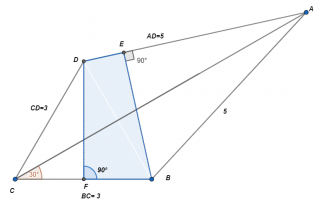Hello,
please, I need help with this math problem:
The convex quadrilateral ABCD with the AB side 5 cm long with the BC side 3 cm long and with a BCD angle of 60 degrees is symmetrical according to the diagonal AC. Point E is the fifth perpendicular from vertex B to the AD side and F is the fifth perpendicular from vertex D to the BC side. Determine the perimeter and content of the DEBF rectangle.
Thank you very much!
please, I need help with this math problem:
The convex quadrilateral ABCD with the AB side 5 cm long with the BC side 3 cm long and with a BCD angle of 60 degrees is symmetrical according to the diagonal AC. Point E is the fifth perpendicular from vertex B to the AD side and F is the fifth perpendicular from vertex D to the BC side. Determine the perimeter and content of the DEBF rectangle.
Thank you very much!

